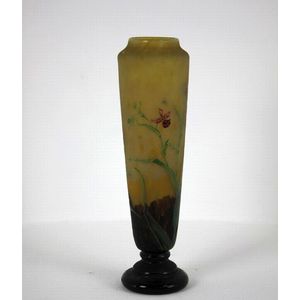Daum Nancy Columbine Enamelled Glass Vase
You must be a subscriber, and be logged in to view price and dealer details.
Subscribe Now to view actual auction price for this item
When you subscribe, you have the option of setting the currency in which to display prices to $Au, $US, $NZ or Stg.
- Baluster (glass) - An architectural term for a column in a balustrade or staircase.
When used to describe glass, it can either refer to the shape of the stem of a wine glass, being slender above and pear shaped below, or the shape of the whole vessel, usually a vase. In fact the baluster shape is often described as being vase-like.
The description of a vase as being of baluster shape covers a wide variety of shapes that often bear no resemblance to the original architectural form. - Acid Etched - Acid etching is often used on glass, metals, and stone to create decorative finishes or to prepare the surface for further treatment or coating. The process of acid etching involves applying an acidic solution, such as hydrochloric acid or nitric acid, to the surface of the material and allowing it to react with the surface. The acid etches away a thin layer of the material, creating a rough, uneven finish. Acid etching can be used to create a variety of different finishes, from a subtle matte finish to a more pronounced, textured finish.
- Etched - Glass decorated with an etched design, which is achieved through marking out the pattern, protecting the area that is not be etched, and then immersing the object in acid to dissolve the surface of the unprotected area. With some glass objects, such as cameo glass, there may be several layers of different coloured glass, and part of the top layer is dissolved leaving the bottom layer as the background. The longer the time of exposure of the object to acid, the deeper the etching.
The word etching is also sometimes used to describe another method of decoration, where wheel grinders were used decorate the surface, but this technique is usually known as engraving. - Circa - A Latin term meaning 'about', often used in the antique trade to give an approximate date for the piece, usually considered to be five years on either side of the circa year. Thus, circa 1900 means the piece was made about 1900, probably between 1895 and 1905. The expression is sometimes abbreviated to c.1900.
This item has been included into following indexes:
Visually similar items

A large Daum Nancy 'Bell Flowers' cameo glass vase, French, circa 1915, the tall baluster body decorated with an acid-etched and enamelled design, on a mottled ground, aid-etched 'Daum Nancy' and the Cross of Lorraine, 35 cm high. Provenance: Christie's Au

19th century Japanese cloisonne tapering square vase

A Daum Nancy 'Birch Leaves' cameo glass vase, French, circa 1910, the tapering cylindrical body rising to a square rim, with an acid-etched design, overlaid in orange glass on a mottled ground, acid-etched 'Daum Nancy' and the Cross of Lorraine, 26.5 cm hi

A pair of Bohemian floral vases, early 20th century, hand painted flared cased glass vases, raised on a socle, white over apple green with floral sprays, gilt highlights and a polished pontil. Height 23.5 cm. Width 15 cm
